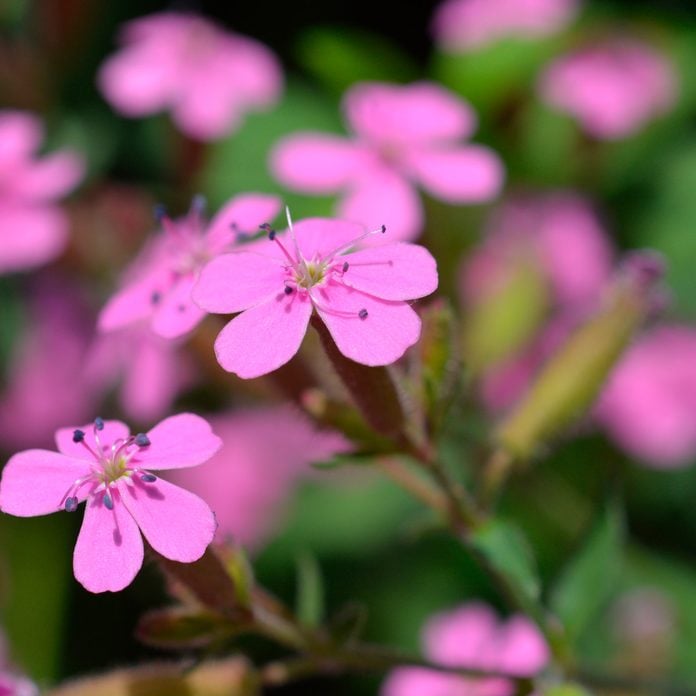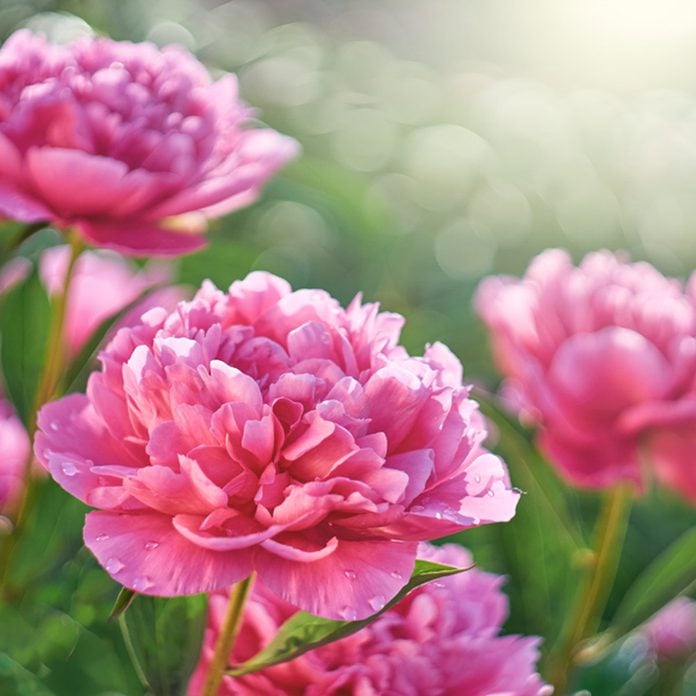
Feather Reed Grass (Calamagrostis acutiflora)
Drought-tolerant grasses are a staple of any xeriscapic (dry) garden. Feather Reed Grass loves full sun and can reach a height of up to 8 feet tall, with a spread of 18 to 24 inches. The feathery grass heads sway beautifully in the breeze, and look superb with the light behind them, or encrusted with frost crystals in winter. This plant grows well in zones 4a through 8b. And if you’d like other ornamental grasses in your garden, here are some more you should get to know.

Pampas Grass (Cortaderia selloana)
The tall plumes of Pampas Grass are impossible to mistake, and they’re often the center of any low-maintenance garden. This perennial evergreen grass prefers full sun or partial shade and can grow in areas with little or no water quite happily. It grows well in zones 7b through 11, and produces muted flowers from late spring through to early fall.
Pampas grass can grow up to 18 feet high, so we don’t recommend it for small gardens, although it can be grown in containers to keep it under control. But, it makes a great plant if you’re looking for some natural privacy.
Don’t build a fence to keep out prying eyes, opt for these plants instead!

American Aloe (Agave americana)
There are many different varieties of aloe, all well-suited for growing in dry conditions, but the American Aloe is one of the best-known. This evergreen plant has fleshy, pointed blue-green leaves edged with sharp thorns. It boasts yellow flowers, in the late spring or early summer, that attract moths, butterflies and bats, and is happy in full sun or partial shade. It grows between 4 and 6 feet high with a spread of 8 to 10 feet, and thrives in Zones 7 through10.
Succulents make great ground cover and are ideal in a dry garden. Here are some more easy-care succulents for you to grow.

Mexican Tuberose (Agave polianthes)
You’re not limited to foliage plants when looking to create a beautiful xeriscapic garden. There are plenty of flowering drought-tolerant plants, too. The Mexican Tuberose is understated, elegant and fragrant. Growing up to 4 feet high and spreading up to 3 feet wide, this lovely plant produces white or yellow flowers in late summer and early fall. As a bonus, these flowers are a magnet for hummingbirds and moths. This plant flourishes in full sun or partial shade and can be grown as far north as Zone 7. However, dig up the rhizomes and store over the winter to protect against frost and ice. These wildflowers do well in the suburbs!

Stonecrop (Sedum spathulifolium)
Stonecrop is one of the best drought-tolerant plants for providing color and ground cover. With distinctive blue-gray leaves and yellow summer flowers, Stonecrop makes a lovely addition to an Alpine or rock garden and is hardy in Zones 4 through 9.
Like all Sedum varieties, Stonecrop is a succulent requiring little water. In fact, it positively thrives in poor, dry soil. This low-growing variety forms dense mats, so it’s great for ground cover, as well as looking beautiful trailing from containers or even hanging baskets.
Low-growing varieties of Stonecrop (such as Cape Blanco), also look beautiful poking through the cracks in a garden path.

Hens & Chicks (Sempervivum)
With plenty of varieties to choose from, Hens & Chicks is named for its habit of self-propagating by putting out mini plants from the main plant. Low-growing and punctuated by taller distinctive flowers, Sempervivum is a wonderful choice for ground cover. You’ve got a range of foliage colors and shapes to choose from, as well as flower colors, and it loves full sun. It’s hardy from Zone 4a upward.
Sempervivum’s spreading, trailing habit makes it the perfect choice for an alpine garden or containers. Here’s our helpful guide to more plants that do well in containers.

Thyme (Thymus)
Who doesn’t love the glorious fragrance of Thyme? This drought-tolerant plant adds a Mediterranean flavor to your cooking, but also makes a sweet-smelling plant for a garden path, releasing its scent as it’s stepped on. It’s also popular in rock gardens, window boxes and containers.
There are lots of varieties of thyme, with foliage ranging across dark and light green to variegated. Flowers are often pink or purple and they attract bees and butterflies. Thyme can grow to around 12 inches high, and spreads up to 18 inches, although you may need to trim it back in spring to avoid die-off in the center of the plant. It grows best in Zones 5a through 9b. This indoor herb planter looks beautiful and saves you running to the backyard while you’re cooking.

Rock Soapwort ( Saponaria ocymoides)
If you want a splash of color in your dry garden, then Rock Soapwort is a superb choice with its profusion of fuchsia-pink flowers in summer (there’s a white variety too if you prefer something a little more delicate). Like many other alpine plants, Rock Soapwort only grows to around 12 inches tall, but it spreads well, and its nickname “Tumbling Ted” describes its habit of growing vigorously over walls, rocks and containers.
Hardy in Zones 2 through 10b, Rock Soapwort will bloom all summer long, attracting a range of beneficial insects, like bees and butterflies, to your garden.
Rock Soapwort is a fabulous low-maintenance ground cover plant. Check out these other low maintenance landscaping hacks to save time.

Peony (Paeonia)
With its green foliage and showy blooms, you wouldn’t think that the Peony does well in a dry garden, but you’d be surprised. Famed for its beautiful frilled flowers, the Peony hails originally from China but is now a staple of many gardens worldwide. And, as the flowers are also fragrant, it’s a popular choice as a cut flower, as well.
Peonies likes full sun or partial shade, and grow to a height and width of up to 35 inches. Another plus is that they are resistant to deer and rabbits. The Peony grows well in Zones 3 through 7b.
Did you know that the pink peony is Meghan Markle’s favorite flower? We’ve also got the lowdown on other British Royal’s best-loved blooms.

Catmint (Nepetia)
Catmint is another fantastic drought-tolerant plant for a xeriscapic garden, with interesting leaves and a wealth of colorful blooms in summer. Growing well in Zones 4 through 9b, foliage colors range from rich green to cooler gray-green, with variegated leaves as a popular choice.
Flowers grow on spikes up to 18 inches tall and can be cool and understated in whites and creams, or range across striking blues, pinks, mauves and purples. These fragrant flowers bloom in late spring and early summer, attracting bees, butterflies and hummingbirds. And here are some more bee-friendly plants to lure these important pollinators to your garden.

Lavender (Lavandula)
It’s easy to see why lavender has gained its place as one of the most popular choices for a dry garden. Needing little attention except for careful pruning (don’t cut back into the old wood), lavender makes a lovely shrub when planted alone, but can make a striking low hedge when planted in a row.
Depending on the variety, the foliage is green or gray-green, and spiky flowers are usually mauve or purple, although white varieties are also available. Lavender is hardy in Zones 5 through 9, although some varieties only do well in Zones 7 through -9. Lavender is famed for its use as a dried flower in lavender sachets to deter household pests and scent your clothes and linens, but it can also be used in cooking and works well as a cut flower.
Bees adore lavender, and it’s also beloved of hummingbirds. If you want to attract hummingbirds to your garden, these plants are a must.

Lenten Rose (Helleborus x hybridus)
One of the first plants to bloom after winter (hence its name!) the Lenten Rose makes a lovely addition to your dry garden. This drought-tolerant beauty boasts delicately streaked flowers in shades of pink, mauve and cream, and often has different-colored flowers on the same plant.
Left to its own devices, the Lenten Rose will flourish and spread, producing a wealth of early blooms that reach up to 18 inches. It is deer-resistant and does well up to Zone 10b.
The Lenten Rose is a popular choice for winter interest in the garden. Take a look at these other plants to make your garden look fabulous all winter long.